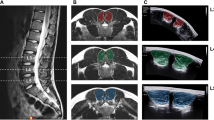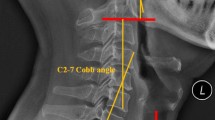Abstract
Study design
A retrospective study.
Objectives
To assess the validity and reliability of cervical sagittal alignment parameters from multipositional magnetic resonance imaging (MRI) and dynamic cervical radiography.
Setting
Hospital in Suzhou, China.
Methods
Patients who underwent both multipositional MRI and dynamic plain radiography of the cervical spine within a 2-week interval between January 2013 and October 2021 were retrospectively enrolled in this study. The C2–7 angle, C2–7 cervical sagittal vertical axis (C2–7 SVA), T1 slope (T1S), cervical tilt, cranial tilt, and K-line tilt were measured in three different positions (neutral, flexion, and extension) with multipositional MRI and dynamic radiography. Inter- and intraobserver reliabilities were assessed by intraclass correlation coefficients (ICCs). Pearson correlation coefficients were used for statistical analyses.
Results
A total of 65 (30 males and 35 females) patients with a mean age of 53.4 years (range 23–69 years) were retrospectively enrolled in this study. Significant positive correlations were noted regarding all parameters between the plain radiographs and multipositional MRI images. Inter- and intraobserver reliabilities were excellent for all cervical sagittal alignment parameters measured in the two imaging modalities. All cervical sagittal parameters had significant positive correlations with those from multipositional MRI in all three positions (p < 0.05). Pearson correlation coefficients demonstrated moderate and strong correlations between the two examinations.
Conclusions
Cervical sagittal alignment parameters measured on multipositional MRI could reliably substitute for those measured on plain radiographs. Multipositional MRI is a valuable, radiation-free alternative for diagnostic evaluation in degenerative cervical diseases.
This is a preview of subscription content, access via your institution
Access options
Subscribe to this journal
Receive 12 print issues and online access
$259.00 per year
only $21.58 per issue
Buy this article
- Purchase on Springer Link
- Instant access to full article PDF
Prices may be subject to local taxes which are calculated during checkout


Similar content being viewed by others
Data availability
The data generated or analyzed during this study can be found in the published article.
References
Batzdorf U, Batzdorff A. Analysis of cervical spine curvature in patients with cervical spondylosis. Neurosurgery. 1988;22:827–36.
Hyun SJ, Kim KJ, Jahng TA, Kim HJ. Relationship between T1 slope and cervical alignment following multilevel posterior cervical fusion surgery: Impact of T1 slope minus cervical Lordosis. Spine (Phila Pa 1976). 2016;41:E396–402.
Tang JA, Scheer JK, Smith JS, Deviren V, Bess S, Hart RA, et al. The impact of standing regional cervical sagittal alignment on outcomes in posterior cervical fusion surgery. Neurosurgery. 2015;76:S14–21.
Scheer JK, Tang JA, Smith JS, Acosta FL Jr., Protopsaltis TS, Blondel B, et al. Cervical spine alignment, sagittal deformity, and clinical implications: a review. J Neurosurg Spine. 2013;19:141–59.
Ferrara LA. The biomechanics of cervical spondylosis. Adv Orthop. 2012;2012:493605.
Boseker EH, Moe JH, Winter RB, Koop SE. Determination of “normal” thoracic kyphosis: a roentgenographic study of 121 “normal” children. J Pediatr Orthop. 2000;20:796–8.
Knott PT, Mardjetko SM, Techy F. The use of the T1 sagittal angle in predicting overall sagittal balance of the spine. Spine J. 2010;10:994–8.
Rose PS, Bridwell KH, Lenke LG, Cronen GA, Mulconrey DS, Buchowski JM, et al. Role of pelvic incidence, thoracic kyphosis, and patient factors on sagittal plane correction following pedicle subtraction osteotomy. Spine (Phila Pa 1976). 2009;34:785–91.
Kim YJ, Bridwell KH, Lenke LG, Rhim S, Cheh G. Pseudarthrosis in long adult spinal deformity instrumentation and fusion to the sacrum: prevalence and risk factor analysis of 144 cases. Spine. 2006;31:2329–36.
Lee SH, Kim KT, Seo EM, Suk KS, Kwack YH, Son ES. The influence of thoracic inlet alignment on the craniocervical sagittal balance in asymptomatic adults. J Spinal Disord Tech. 2012;25:E41–7.
Gelb DE, Lenke LG, Bridwell KH, Blanke K, McEnery KW. An analysis of sagittal spinal alignment in 100 asymptomatic middle and older aged volunteers. Spine. 1995;20:1351–8.
Jang JS, Lee SH, Min JH, Kim SK, Han KM, Maeng DH. Surgical treatment of failed back surgery syndrome due to sagittal imbalance. Spine. 2007;32:3081–7.
Xing R, Liu W, Li X, Jiang L, Yishakea M, Dong J. Characteristics of cervical sagittal parameters in healthy cervical spine adults and patients with cervical disc degeneration. BMC Musculoskelet Disord. 2018;19:37.
Fujiyoshi T, Yamazaki M, Kawabe J, Endo T, Furuya T, Koda M, et al. A new concept for making decisions regarding the surgical approach for cervical ossification of the posterior longitudinal ligament: the K-line. Spine. 2008;33:E990–3.
Lee H, Nicholson LL, Adams RD. Cervical range of motion associations with subclinical neck pain. Spine. 2004;29:33–40.
Lee HD, Jeon CH, Chung NS, Kwon HJ. Comparative analysis of three imaging modalities for evaluation of cervical sagittal alignment parameters: a validity and reliability study. Spine. 2017;42:1901–7.
Kim HS, Kim TH, Park MS, Kim SW, Chang HG, Kim JH, et al. K-line tilt as a novel radiographic parameter in cervical sagittal alignment. Eur Spine J. 2018;27:2023–8.
Nash CL Jr., Gregg EC, Brown RH, Pillai K. Risks of exposure to X-rays in patients undergoing long-term treatment for scoliosis. J Bone Joint Surg Am. 1979;61:371–4.
Goldberg MS, Mayo NE, Levy AR, Scott SC, Poitras B. Adverse reproductive outcomes among women exposed to low levels of ionizing radiation from diagnostic radiography for adolescent idiopathic scoliosis. Epidemiology. 1998;9:271–8.
Bone CM, Hsieh GH. The risk of carcinogenesis from radiographs to pediatric orthopaedic patients. J Pediatr Orthop. 2000;20:251–4.
Kleinerman RA. Cancer risks following diagnostic and therapeutic radiation exposure in children. Pediatr Radiol. 2006;36:121–5.
Shi B, Mao S, Wang Z, Lam TP, Yu FW, Ng BK, et al. How does the Supine MRI correlate with standing radiographs of different curve severity in adolescent idiopathic Scoliosis? Spine. 2015;40:1206–12.
Lee MC, Solomito M, Patel A. Supine magnetic resonance imaging Cobb measurements for idiopathic scoliosis are linearly related to measurements from standing plain radiographs. Spine. 2013;38:E656–61.
Tykocki T, du Plessis J, Wynne-Jones G. Correlation between the severity of myelopathy and cervical morphometric parameters on dynamic magnetic resonance imaging. Acta Neurochir. 2018;160:1251–8.
Joaquim AF, Baum GR, Tan LA, Riew KD. Dynamic cord compression causing cervical myelopathy. Neurospine. 2019;16:448–53.
Michelini G, Corridore A, Torlone S, Bruno F, Marsecano C, Capasso R, et al. Dynamic MRI in the evaluation of the spine: state of the art. Acta Biomed. 2018;89:89–101.
Nigro L, Donnarumma P, Tarantino R, Rullo M, Santoro A, Delfini R. Static and dynamic cervical MRI: two useful exams in cervical myelopathy. J Spine Surg. 2017;3:212–6.
Qiao J, Zhu F, Liu Z, Xu L, Zhu Z, Qian B, et al. Measurement of thoracic inlet alignment on MRI: Reliability and the influence of body position. Clin Spine Surg. 2017;30:E377–E380.
Xing R, Zhou G, Chen Q, Liang Y, Dong J. MRI to measure cervical sagittal parameters: a comparison with plain radiographs. Arch Orthop Trauma Surg. 2017;137:451–5.
Oshina M, Tanaka M, Oshima Y, Tanaka S, Riew KD. Correlation and differences in cervical sagittal alignment parameters between cervical radiographs and magnetic resonance images. Eur Spine J. 2018;27:1408–15.
Jun HS, Chang IB, Song JH, Kim TH, Park MS, Kim SW, et al. Is it possible to evaluate the parameters of cervical sagittal alignment on cervical computed tomographic scans? Spine. 2014;39:E630–6.
Zhong G, Buser Z, Lao L, Yin R, Wang JC. Kinematic relationship between missed ligamentum flavum bulge and degenerative factors in the cervical spine. Spine J. 2015;15:2216–21.
Hayashi T, Wang JC, Suzuki A, Takahashi S, Scott TP, Phan K, et al. Risk factors for missed dynamic canal stenosis in the cervical spine. Spine. 2014;39:812–9.
Paholpak P, Tamai K, Shoell K, Sessumpun K, Buser Z, Wang JC. Can multi-positional magnetic resonance imaging be used to evaluate angular parameters in cervical spine? A comparison of multi-positional MRI to dynamic plain radiograph. Eur Spine J. 2018;27:1021–7.
Sodickson A, Baeyens PF, Andriole KP, Prevedello LM, Nawfel RD, Hanson R, et al. Recurrent CT, cumulative radiation exposure, and associated radiation-induced cancer risks from CT of adults. Radiology. 2009;251:175–84.
Doody MM, Lonstein JE, Stovall M, Hacker DG, Luckyanov N, Land CE. Breast cancer mortality after diagnostic radiography: findings from the U.S. Scoliosis Cohort Study. Spine. 2000;25:2052–63.
Sierink JC, van Lieshout WA, Beenen LF, Schep NW, Vandertop WP, Goslings JC. Systematic review of flexion/extension radiography of the cervical spine in trauma patients. Eur J Radiol. 2013;82:974–81.
Zhou Z, Jin Z, Zhang P, Shan B, Zhou Z, Zhang Y, et al. Correlation between dural sac size in dynamic magnetic resonance imaging and clinical symptoms in patients with lumbar spinal Stenosis. World Neurosurg. 2020;134:e866–e873.
Funding
This research is funded by the Suzhou Special Foundation of Clinical Key Diseases Diagnosis and Therapy (LCZX501904).
Author information
Authors and Affiliations
Contributions
All authors contributed to the study conception and design. Material preparation, data collection, and analysis were performed by Zhiqiang Zhou, Fanguo Lin, Yao Zhang, Zhigao Jin, Dong Liu, and Yekun Deng. The first draft of the manuscript was written by Zhiqiang Zhou, Fanguo Lin, and Yao Zhang, reviewed and edited by Xiaotong Wang and Xiaozhong Zhou. All authors read and approved the final manuscript.
Corresponding authors
Ethics declarations
Competing interests
The authors declare no competing interests.
Ethics approval
All procedures performed in studies involving human participants were in accordance with the ethical standard of the institutional and/or national research committee and with the 1964 Helsinki declaration and its amendments or comparable ethical standards. This study was ethically approved by the institutional review board of the Second Affiliated Hospital of Soochow University.
Consent to participate
Informed consent was obtained from all individual participants included in the study.
Consent to publication
Patients signed informed consent regarding publishing their data and photographs.
Additional information
Publisher’s note Springer Nature remains neutral with regard to jurisdictional claims in published maps and institutional affiliations.
Supplementary information
Rights and permissions
Springer Nature or its licensor (e.g. a society or other partner) holds exclusive rights to this article under a publishing agreement with the author(s) or other rightsholder(s); author self-archiving of the accepted manuscript version of this article is solely governed by the terms of such publishing agreement and applicable law.
About this article
Cite this article
Zhou, Z., Lin, F., Zhang, Y. et al. Correlation and reliability of cervical sagittal alignment parameters between plain radiographs and multipositional MRI images. Spinal Cord 61, 307–312 (2023). https://doi.org/10.1038/s41393-023-00895-1
Received:
Revised:
Accepted:
Published:
Issue Date:
DOI: https://doi.org/10.1038/s41393-023-00895-1



